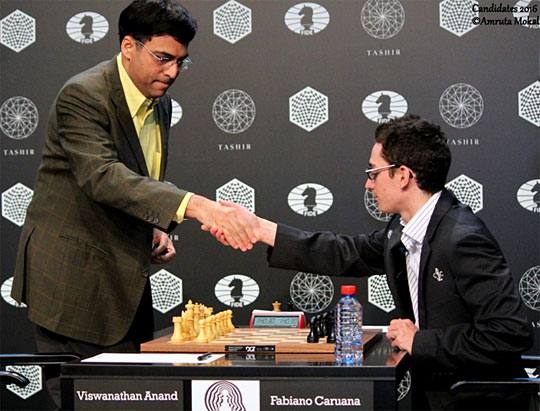



The 2016 FIDE World Chess Candidates Tournament is a 14-round event, which determines the next Challenger to Magnus Carlsen's title, is taking place in Moscow from March 10–30. Eight players, including six of the World’s top-ten rated grandmasters. The time control is 100 minutes for the first 40 moves, 50 minutes for the next 20 moves and then 15 minutes for the rest of the game, plus an additional 30 seconds per move starting from move one. The guaranteed prize fund is US $420,000.
A full report with more pictures, ananlysis, opinions, will follow soon.
Here for now are the results, game summaries and a few pictures.
| Round 3, Sunday 13 March 2016 | ||
| Nakamura Hikaru |
½-½
|
Svidler Peter |
| Giri Anish |
½-½
|
Karjakin Sergey |
| Anand Viswanathan |
½-½
|
Caruana Fabiano |
| Topalov Veselin |
0-1
|
Aronian Levon |
Video: Daniel King on Giri vs Karjakin and Topalov vs Aronian
As we said in the blurb, all the games of round three had some or the other interesting moment in them. For example: Anish was a pawn up against Karjakin and later sacrificed a piece, Anand was ready to expose his king with the move gxh4 to prove that he had an edge, Aronian showed some new ideas in the opening and Topalov played what was the worst game of his life, and lastly Svidler showed some phenomenal preparation and pressed Nakamura right to the very end. We have three leaders now: Vishy Anand, Sergey Karjakin and Levon Aronian, all on 2.0/3.


Anish Giri was in a jovial mood at the start of the round.
Here he is seen chatting with the chief arbiter Werner Stubenvoll.

But as the game progressed he wasn’t particularly happy with the position he got out of the opening
"Sergey played the (Queen’s Indian) structure so well yesterday with white against Nakamura that I thought he won’t repeat the same with the black pieces today.” That is what Anish Giri said in the press conference after his game against Sergey Karjakin. But the Russian grandmaster has no such prejudices. He learnt from his opponent’s (Nakamura’s) mistakes and applied it in his own game today. Not going for c7-c5 and keeping the pawn on c6 was one such improvement. It seemed as if Black was comfortable, but suddenly Karjakin pushed his pawn to h5. As Alexandra Kosteniuk pointed out, “Yesterday the move h2-h4 proved highly successful against Nakamura, and maybe Sergey wanted to try something similar again!” However, the move 18…h5 was a bad one and Anish took advantage of it with the move 19.Bh3. The Dutch GM could have very well got a huge advantage with the move 20.f3 instead of 20.Nf4, which he played in the game (further analysis show that 20.f3 might also be not sufficient for a huge edge). After the inaccuracy the game was still interesting, but the danger had passed for Sergey. He sacrificed a pawn for compensation. Giri retaliated with a piece sacrifice. But that was clearly not enough and he had to repeat the moves and split the point.

I cannot believe I didn’t play 20.f3!?
Anish discusses the game with his opponent Sergey Karjakin.

Vishy Anand tried to put pressure on his opponent, but Fabiano Caruana was up to the task
After the moves 1.e4 e5 2.Nf3 Nc6 3.Bb5 ask what the black pawn on a7 feels. No one cares about it anymore! Caruana too played 3…Nf6 and Anand took the game into the Anti-Berlin territory with 4.d3. Fabiano must have definitely studied the game Anand against Topalov from round one. Hence, Anand deviated on move seven with 7.h3 instead of 7.Nbd2. That put Fabiano into some thought. He came up with this interesting plan of ...exd4 followed by ...c5! In the ensuing middlegame Black was saddled with a small weakness on d6 that was compensated by active pieces. Anand held an advantage and with Caruana approaching time pressure, things looked good for Vishy. But the American kept his calm and combined with some indecisiveness from Vishy the game was abruptly drawn due to many exchanges.

Caruana hasn’t shown anything special in these three rounds of the Candidates 2016,
but he is solidly placed with 1.5/3

A win against Topalov, successful opening preparation against Levon Aronian and having the better side of a draw against Fabiano Caruana – the first three rounds of the tournament have gone well for Vishy Anand.

Levon Aronian’s new idea in the opening and Veselin Topalov’s over-ambitious approach,
led to a relatively easy win for the Armenian. Aronian now joins the leaders with 2.0/3.
It was one of those games that Topalov would want to forget. First he was outprepared as Aronian essayed a new idea in the English Four Knights from the black side. Veselin was ambitious and didn’t want to settle for an equal position. He tried to be adventurous and it ended up badly. After just thirteen moves he was worse. A blunder on the seventeenth move cost the Bulgarian another pawn. And although Aronian was far from his best in converting the plus position, the situation was so much in his favour that these small inaccuracies didn’t matter. A relatively easy win for Levon who now joins the leaders Anand and Karjakin.

Two losses in three games and yet he has a smile on his face: hats off to Veselin Topalov!
After the game I went up to Veselin and asked him the following question, “I have been following you since the London Chess Classic. Over there and in the first three rounds of the Candidates your performance hasn’t been so great. Yet you always maintain a smile on your face and show some great sportsman spirit in the press conference. We haven’t really seen this in any of the top players. Can you tell me how you maintain such a positive attitude?” To which Topalov thought for a while and said, “You know, I wasn’t really planning to play in this Candidates event. At the last moment I said let’s give it a try. The thing with these tournaments is that you have to finish first. Other spots don’t really matter. It will not make a difference whether you are second or eighth. Right now it doesn’t matter much to me that I am losing. Tomorrow is a rest day and I hope to be back refreshed.”

Hikaru Nakamura vs Peter Svidler was, perhaps, the most interesting game of round three

One hour forty-five minutes on the clock after twenty five moves! Amazing opening preparation by Svidler
Peter Svidler was on fire today. He had prepared his opening in such great depth that it was simply mind blowing! Nakamura started with 1.d4, maybe expecting that Peter would reply with the Grunfeld. However, Svidler stuck to the same line he played against Karjakin in the first round. While Karjakin had opted for the relatively safe 9.Nxd4, Nakamura chose the much more critical 9.cxd4 line. Until move 20 it seemed that both the players were relatively well prepared. But Peter went a step further and showed that he had seen the position in much greater depth. When he made his 25th move he already had one hour forty five minutes on his clock – five minutes more than when he started the game! Nakamura was in great difficulties. With immense resourcefulness he steered the game towards a rook + knight endgame in which he was a pawn down. Whether that endgame is winning or not requires the microscopic eye of our endgame expert Karsten Mueller. But sufficient to say that Svidler ran out of energy towards the end and Hikaru was able to hold the game. A great battle indeed and at some levels both players could claim a moral victory out of it.

Finally a draw offer with this last game ending at 20:46 Moscow time

A tired but at the same time relieved Hikaru Nakamura. It was an amazing piece of defensive effort by the American grandmaster. When your opponent is playing so quickly and has everything prepared it is often difficult to maintain your cool. But Hikaru did just that. I feel that this was a very important game for him. After the rest day we might see a completely rejuvenated Nakamura who may start winning one game after another.

“As surprising as it may sound I still work sometimes on chess!” – Peter Svidler
when asked how he prepared the line in such great depth.
Video: Peter Svidler on his phenomenal preparation against Nakamura.
Subscribe to ChessBase India's YouTube channel to see some interesting chess related videos.

Zurab Azmaiparashvili and Kirsan Illyumzhinov, ECU and FIDE presidents respectively,
keenly follow the games at the start of the third round

By far the cutest player in the tournament hall! This nine-year-old kid was the Moscow
Under Nine finalist and made the opening move in the game between Anand and Caruana.

We wonder how strong Sopiko Guramashvili will become in a few years from now. She is currently an IM and rated 2390, but constantly following high level games of Anish, and discussing games with a strong trainer like Vladimir Tukmakov, is bound to improve her chess! We won’t be surprised if she becomes a full-fledged grandmaster soon.

Chess like love, like music, has the power to make a man happy! – Siegbert Tarrasch

There are chess boards set up outside the playing hall along with DGT clocks, and any spectator can come and play a few games on it. Mind you, the pieces are the same as the ones being used by the players inside the playing hall. On some boards you have grandparents playing…

…while on others you have the grandchildren!

Three strong grandmasters, Evgeniy Najer, Sanan Sjugirov and Jakov Geller
try to make Anish Giri’s piece sacrifice work

The young and talented local grandmaster Vladimir Fedoseev analyzing with a friend

Former Women’s World Champion Alexandra Kosteniuk is doing
an excellent job as the official commentator at the event

Co-anchor is the experienced Ukrainian grandmaster and trainer Evgeny Miroshnichenko. Apart from commentating Miro is also creating some valuable training material for the viewers. For example: on the third day he showed us this very instructive study. Have a crack at it yourself, and if you do find the answer post it in the comments section below:

The black knight seems to have blockaded the d6 pawn and will not let it pass.
But White can win here. Can you see how?
14th of March, Monday, is a rest day for the players. We will be back with in-depth coverage from the venue for the fourth round on Tuesday. Stay tuned for all the action.
Pictures by Amruta Mokal of ChessBase India
|
|
|||||||||||||||||||||||||||||||||||||||||||||||||||||||||||||||||||||||||||||||||||||||||||||||||||||||||||||||||||||||||||||||||||||||||||||||||||||||||||||||||||||||||||||||||||||||||||||||||||||||||||||||||||||||||||||||